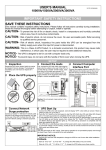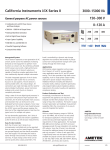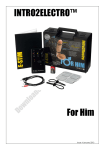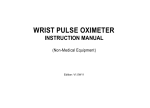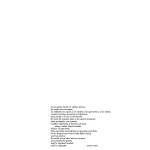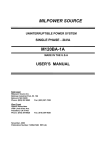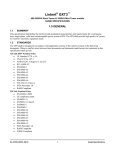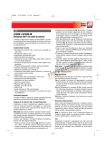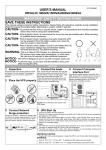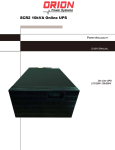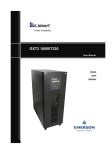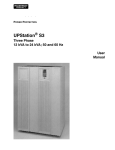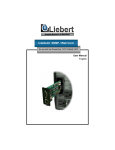Download Static Uninterruptible Power Supply Systems Liebert - e
Transcript
Static Uninterruptible Power Supply Systems Liebert UPStation GXT 3G UPS GUIDE SPECIFICATIONS 700 to 3000 VA Rack Tower Single - Phase Uninterruptible Power Supply System 1.0 GENERAL 1.1 SUMMARY This specification defines the electrical and mechanical characteristics and requirements for a continuous-duty single-phase, solid-state, uninterruptible power system. The uninterruptible power system, hereafter referred to as the UPS, will provide high-quality AC power for sensitive electronic equipment loads. 1.2 STANDARDS The UPS is designed in accordance with the applicable sections of the current revision of the following documents. Where a conflict arises between these documents and statements made herein, the statements in this specification shall govern. IEC/EN/AS 62040-1-1:2008 IEC/EN/AS 62040-2 2nd Ed IEC 61000-3-2 (Harmonics) IEC61000-3-12 IEC/EN/AS 62040-2 2nd Ed ISTA Procedure 1A Certification C-Tick (Australia / New Zealand will pursue certification) WEEE and ROHS (6 by 6) EU REACH Compliant 1.3. SYSTEM DESCRIPTION 1.3.1 Modes of Operation The UPS is designed to operate as a true on-line double conversion system in the following modes: A. Normal - In normal operation incoming AC power is fed to the input power factor corrected (PFC) rectifier that converts the AC power to DC power for the inverter. In this mode, power is also derived from utility power for the battery charger. The inverter derives DC power from either the PFC rectifier or the battery and regenerates filtered and regulated AC sinewave power for the connected load. The battery will be charged once the unit is connected to utility power, regardless of whether the UPS is ON or OFF. In the event of a utility outage or severe abnormality (sag or swell), the inverter will support the connected load from battery power, until the battery is discharged or the utility returns; whichever occurs first. B. Battery - Upon failure of utility / mains AC power, the critical AC load is supplied by the inverter, which obtains power from the battery. There is no interruption in power to the critical load upon failure or restoration of the utility / mains AC source. C. Recharge - Upon restoration of utility / mains AC power, after a utility / mains AC power outage, the input converter automatically restarts and assumes supplying power to the inverter and the battery charger to recharge the battery. D. Automatic Restart - Upon restoration of utility / mains AC power, after a utility mains AC power outage and complete battery discharge, the UPS automatically restarts and assumes supplying power to the critical load and the battery charger automatically recharges the battery. This feature shall be capable of being disabled by the user. E. Bypass - The integral bypass performs an automatic transfer of the critical AC load from the inverter to the bypass source, in the event of an overload, PFC failure, over temperature, DC Bus over voltage, or inverter failure conditions. 1.3.2 Design Requirements A. Voltage: Input/output voltage specifications of the UPS are: Input: 0 - 280 VAC, 50/60 Hz, single-phase, 2-wire-plus-earth. (L, N, G, with N floating or bonded to G at the power source, neutral should be treated as a high voltage phase conductor for spacing requirements). The AC input will power the PFC input and BYPASS. Output: 230 VAC (user configurable: 220V, 230V, 240V) +3%, 50/60 Hz, single-phase, 2-wire-plus-earth. B. Output Load Capacity: Specified output load capacity of the UPS is: 700 VA/630 Watts at 0.9 lagging power factor. 1000 VA/900 Watts at 0.9 lagging power factor. 1500 VA/1350 Watts at 0.9 lagging power factor. 2000 VA/1800 Watts at 0.9 lagging power factor. 3000 VA/2700 Watts at 0.9 lagging power factor. C. Internal Battery: Valve regulated, non-spillable, flame retardant, lead acid cells. D. Reserve Time: 700 VA minimum 6 minutes, 1000 VA to 3000 VA minimum 4 minutes, these times are at full load with ambient temperature of 25C (77F). E. Battery Recharge: The UPS contains a battery recharge rate designed to prolong battery life. Recharge time for UPS internal batteries is three (3) hours maximum to 90% capacity after a complete discharge into full load. 1.3.3 Performance Requirements 1.3.3.1 AC Input to UPS A. Voltage Configuration: The UPS operates at these values without drawing power from the batteries. 230 VAC; single phase, 2 wire plus earth nominal; variable based upon output loading: 700/1000/1500/2000 VA MODELS LOAD TRANSFER VOLTAGE COMEBACK VOLTAGE 91% 169 VAC 183 VAC 71% 151 VAC 165 VAC 31% 116 VAC 130 VAC 3000 VA MODEL LOAD TRANSFER VOLTAGE COMEBACK VOLTAGE 91% 185 VAC 199 VAC 71% 162 VAC 176 VAC 31% 116 VAC 130 VAC B. Frequency: UPS auto senses input frequency when first powered up and will operate within the following frequency specifications. UPS is capable of Cold Start with default output of frequency of 50 Hz/ 230 VAC. Once started frequency operating window is 40-70 Hz. Auto frequency sensing (factory default setting), 50 Hz. frequency conversion, and 60 Hz. frequency conversion. C. Input Power Factor: >0.97 lagging at rated load. D. Input Current reflected distortion: 3-5% THD maximum. 700VA-1500VA: 5% at Linear Load 2000VA-3000VA: 3% at Linear Load E. Input Current Ratings: MODEL 230 VAC Units 700VA 3.1A 1000VA 3.4A 1500VA 6.5A 2000VA 8.7A 3000VA 13A F. Inrush Current (initial start up, no load): The UPS has a maximum inrush current of 6 times the full load peak input current. G. Input Line Transient Immunity: UPS conforms to an input line transient conforming to IEC/EN/AS 62040-2 2nd Ed. H. Surge Protection: 230 VAC units: MOV ratings will be 320 Volt, 80 Joules minimum. They will be connected L-N. 1.3.3.2 AC Output, UPS Inverter A. Voltage Configuration: 230 V Units: 230 VAC, 50/60 Hz, single-phase, 2-wire-plus-earth, configuration program selectable (220V, 230V, 240V). B. Voltage Regulation: + 3% steady state. C. Frequency Regulation: + 5% Synchronized to utility / mains. + 0.1 Hz free running or on battery operation. D. Frequency Slew Rate: 1.0 Hertz per second maximum E. Voltage Distortion: ≤3% total harmonic distortion (THD) typical into a 100% linear load, ≤5% THD typical into a 100% non-linear load with crest factor ratio of 3:1. F. Load Power Factor Range: 0.9 lagging G. Output Power Rating: 700 VA/630 Watts, 1000 VA/900 Watts, 1500 VA/1350 Watts, 2000 VA/1800 Watts, and 3000 VA/2700 Watts at 0.9 lagging power factor. H. Inverter Overload Capability: 105-125% for 60 seconds then transfer to bypass, 125 - 150% for 50 seconds then transfer to bypass, 150-200% for 2 seconds then transfer to bypass, > 200% for 250 msecs. minimum then transfer to bypass. H. Voltage Transient Response: + 7% in line mode 0-100-0 % loading of the UPS, I. Transient Recovery Time: To nominal voltage within 90 milliseconds. Test method is according to IEC62040-3 J. Efficiency: ≥ 88% AC–AC, minimum 1.4 ENVIRONMENTAL CONDITIONS A. Ambient Temperature: Operating: 0O C to +25O C for altitudes 0 to 3000 meters (0 to 10,000 ft.) above sea level. 25O C for optimum battery performance Storage: -15O C to +50O C with batteries removed. 20O C for optimum battery storage. B. Relative Humidity: Operating: 0 to 95% non-condensing. Storage: 0 to 95% non-condensing. C. Altitude: 3,000 m / 10,000 ft. maximum without power derating when operated within the temperature specified in section 1.4.A. Ambient temperature will be derated 5° C for each additional 500 meters. D. Audible Noise: Noise generated by the UPS under normal operation does not exceed 48dBA when measured at 1 meter from the surface of the UPS. E. Electrostatic Discharge: The UPS is able to withstand an electrostatic discharge compliant to IEC610004-2, level 4, for 230 VAC units (15 kV through air, 8 kV contact) without damage and will not affect the connected load. 1.5 USER DOCUMENTATION The specified UPS system is supplied with one (1) user's manual. The User’s Manuals include installation drawings and instructions, a functional description of the equipment with block diagrams, safety precautions, illustrations, step-by-step operating procedures, and general maintenance guidelines. 1.6 WARRANTY The UPS manufacturer warrants the UPS against defects in materials and workmanship for two (2) years. An optional one (1) and three (3) year full coverage extension warranty are available upon request. 1.7 QUALITY ASSURANCE 1.7.1 Manufacturer Qualifications A minimum of twenty year's experience in the design, manufacture, and testing of solid-state UPS systems is required. 1.7.2 Factory Testing Before shipment, the manufacturer fully and completely tests the system to assure compliance with the specification. These tests include operational discharge and recharge tests on the internal battery to assure performance. 2.0 PRODUCT 2.1 FABRICATION All materials and components making up the UPS are new, of current manufacture, and have not been in prior service except as required during factory testing. All relays are provided with dust covers. 2.1.2 Wiring Wiring practices, materials, and coding are in accordance with the requirements the standards listed in section 1.2 and other applicable codes and standards. All wiring is copper. 2.1.3 Cabinet The UPS unit is comprised of: input converter, battery charger, inverter, and battery consisting of the appropriate number of sealed battery cells; and is housed in a rack - tower NEMA type 1 enclosure and meet the requirements of IP20. The UPS cabinet is cleaned, primed, and painted. Dimensions and weights are: 2.1.4 MODEL DIMENSIONS (W x D x H) WEIGHT 700VA 85 mm X 500 mm X 430 mm 20 kg 1000VA 85 mm X 500 mm X 430 mm 20 kg 1500VA 85 mm X 500 mm X 430 mm 23 kg 2000VA 85 mm X 500 mm X 430 mm 23.5 kg 3000VA 85 mm X 600 mm X 430 mm 32.4 kg Cooling The UPS is forced air cooled by an internally mounted, continuous fan. Fan power is provided from the internal DC supply. Air intake is through the front of the unit and exhausted out the rear of the unit. 2.2 COMPONENTS 2.2.1 Input Converter 2.2.1.1 General Incoming AC power is converted to a regulated DC output by the input converter for supplying DC power to the inverter. The input converter provides input power factor correction and input current distortion reduction. 2.2.1.2 AC Input Current Limit The input converter is provided with AC input current limiting whereby the maximum input current is limited to 125% of the full load input current rating. 2.2.1.3 Input Protection The UPS has built-in protection against undervoltage, overcurrent, and overvoltage conditions including low-energy lightning surges, introduced on the primary AC source. The 230V models have circuit breakers. 2.2.1.4 Battery Recharge The UPS contains a battery recharge rate designed to prolong battery life. The battery is constant current charged to restore capacity, and then shall be constant voltage charged to maintain the battery in a fully charged state. Recharge time for the internal UPS batteries shall be three (3) hours maximum to 90% capacity (full load discharge rate). There is DC overvoltage protection so that if the DC voltage exceeds the pre-set limit, the UPS will shutdown automatically and the critical load is transferred to bypass. 2.2.2 Inverter 2.2.2.1 General The UPS inverter is a pulse-width-modulated (PWM) design capable of providing the specified AC output. The inverter converts DC power from the input converter output, or the battery, into precise sine wave AC power for supporting the critical AC load. 2.2.2.2 Overload The inverter is capable of supplying current and voltage for overloads exceeding 100% and up to 200% of full load current. A visual indicator and audible alarm indicates overload operation. For greater currents or longer time duration, the inverter has electronic current-limiting protection to prevent damage to components. The inverter is selfprotecting against any magnitude of connected output overload. Inverter control logic senses and disconnects the inverter from the critical AC load without the requirement to clear protective devices. 2.2.2.3 Inverter DC Protection The inverter is protected by the following DC shutdown levels: DC Overvoltage Shutdown DC Undervoltage Shutdown (End of Discharge) DC Undervoltage Warning (Low Battery Reserve); factory default set at 2 minutes (user configurable 2 to 30 minutes). 2.2.2.4 Output Frequency The inverter holds the output frequency to + 0.1 Hz of nominal when not synchronized to the utility/mains source. 2.2.2.5 Output Protection The UPS inverter employs electronic current limiting circuitry. 2.2.2.6 Battery Over Discharge Protection To prevent battery damage from over discharging, the UPS control logic automatically raises the shutdown voltage set point; dependent upon output load at the onset of battery operation. 2.2.3 Display and Controls 2.2.3.1 General The UPS is provided with a microprocessor based unit status display and controls section designed for convenient and reliable user operation. The monitoring functions such as status and alarm indicators are displayed on an LED display. 2.2.3.2 System Indicators The UPS contains a row of LED's to indicate UPS load and battery capacity and five single LED's to indicate UPS status as described below: The "Fault" LED indicator illuminates red to indicate a UPS fault condition. The "Battery" LED indicator illuminates amber to indicate the UPS is operating from battery power. The "Bypass" LED indicator illuminates amber to indicate the UPS is operating on Bypass power. An audible alarm is provided and activated by any of the above alarm conditions. The "UPS ON" LED indicator illuminates green to indicate the UPS inverter is operating and supplying power. The "AC Input" LED indicator illuminates green to indicate the UPS is operating from utility / mains power. 2.2.3.3 Controls UPS start-up and shutdown operations are accomplished by the "ON" and "OFF" push buttons located on the front panel of the UPS. The "ON" push button is a means to turn the UPS on and also serve as a means to manually test the battery and to reset active visual and audible alarms. The "OFF" push button allows manual transfers of the load from the inverter to bypass power. Pressing the "OFF" push button twice within a four second time period will completely shutdown the UPS and its connected load in normal and battery mode. 2.2.4 On-Line Battery Test The UPS is provided with an automatic biweekly battery test feature (factory default). Via the set-up configuration program on a Windows based PC the automatic battery test can be disabled or configured to operate every 7, 14, 21, or 28 days. The battery test will ensure the capability of the battery to supply power to the inverter while loaded. If the battery fails the test, the UPS will display a warning message to indicate the internal batteries need replaced. The battery test feature is user accessible by the push button located on the front of the unit and with Communications Software. The Automatic Battery test feature is capable of being disabled through the UPS User Configuration Program. 2.2.5 Bypass 2.2.5.1 General A bypass circuit is provided as an integral part of the UPS. The bypass control logic contains an automatic transfer control circuit that senses the status of the inverter logic signals, and operating and alarms conditions. This control circuit provides a transfer of the load to the bypass source if available, and if the inverter is capable of powering the load (i.e. overload condition, if your unit is in Manual Bypass Mode, or if the voltage and or frequency is out of tolerance). 2.2.5.2 Automatic Transfers The transfer control logic automatically activates the bypass, transferring the critical AC load to the bypass source, after the transfer logic senses one of the following conditions: UPS overload UPS over temperature PFC failure Inverter failure DC Bus Overvoltage Once overload condition is reduced, the load is automatically transferred back to inverter power. 2.2.6 Internal Battery Valve regulated, non-spillable, flame-retardant lead acid cells are used as a stored-energy source for the specified UPS system. The battery is housed internal to the UPS cabinet, and sized to support the inverter at rated load and power factor, with ambient temperature of 25 O C (77 O F) for a minimum of 7 minutes reserve time. The expected life of the battery shall be 3 - 5 years or a minimum 250 complete discharge cycles. The UPS units have the capability to allow the operator to replace the internal battery. 2.2.7. Output Distribution Output distribution is integral to the UPS, and located on the rear of the unit. 2.2.8 MODEL 230 VAC Units 700VA (6) EN 60320/C13 1000VA (6) EN 60320/C13 1500VA (6) EN 60320/C13 2000VA (6) EN 60320/C13 3000VA (6) EN 60320/C13 (1) EN 60320/C19 Power Output Distribution Option This option provides maintenance bypass capability as well as power output distribution. It can be used on UPSs in the rack mount or tower configuration. This equipment provides an isolated path of power for your UPS system for preventive maintenance or service. Rack Support Rail Kit Option This kit contains parts needed to mount the Uninterruptible Power Supplies (UPS) and Battery Cabinets into Standard Racks that are 18" to 32" deep. The weight limit per pair of Adjustable Rack-Mounting Brackets is 200 pounds (91 Kg). The Adjustable Rack-Mounting Brackets feature Retaining Latches to prevent users from inadvertently sliding the UPS or Battery Cabinet out of the Rack. 2.2.9 Communication Options 2.2.9.1 USB Serial Port The UPS contains USB Port connector on the rear panel to allow UPS status communications to a computer system. It enables to signal on battery and low battery operational status. 2.2.9.2 Intellislot™ Communications The UPS includes one Intellislot communication port to allow the operator to field-install optional Intellislot communication cards. Intellislot cards may be installed during any state of UPS operation (On, Standby, or Off states). Available Intellislot options are described below. SNMP / WEB CARD This option delivers SNMP and Web management to the UPS when connected to any 10 or 100 Mbit Ethernet network. The card supports 10 and 100 Mbit Ethernet and provides for in-the-field upgrade of SNMP firmware. The kit includes the Intellislot card, MIB, configuration cable and installation manual. Relay Interface Card This option provides contact closures for remote monitoring of alarm conditions in the UPS, delivering signals for On Battery, On Bypass, Low Battery, Summary Alarm, UPS Fault and On UPS. The contacts are rated for 24 volts AC or DC at 1A. Connections are to a DB25F connector with cable provided by the end user. 4 Way MultiPORT Relay Interface Card This option splits the UPS photo-coupler signals (on battery, and low battery) into four isolated sets of signals, enabling the user to interface with four servers simultaneously. 2.2.9.3 Emergency Power Off (EPO) The UPS has Emergency Power Off (EPO) capabilities. This allows the user to power off the UPS in case of emergency. 2.3 Configuration Program This UPS will have the function of flash update. All the models need a CD with configuration program to allow the end user to “configure” the UPS for their specific operation parameters. Each UPS will be supplied with a CD with configuration program to allow the end user to “configure” the UPS for their specific operation parameters. The parameters are enable/disable auto-restart, enable/disable/program time interval for the automatic battery test; select the desired output voltage (to match input voltage), and low battery warning time and operation as a frequency converter. The end user will also be able to update the battery run timetable by selecting the number and type of battery cabinets installed. The factory default run timetable will be for the internal (or standard) battery. This configuration program will be capable of being run on computers using Windows 2000, Windows XP, Windows Vista operating system. The program will utilize drop down box selection format for ease of use by the end user. Once all the criteria have been selected, the program will download the appropriate information to non-volatile memory. Configuration of the UPS is to occur with the unit plugged into utility/mains and with the unit off. A message that the configuration was completed successfully will appear on the end user’s computer, then a message to tell the user to press the on button to start the UPS. Use of this configuration program will not be required for the unit to operate with factory default settings, but only if the end user wants to change (customize) some settings.











